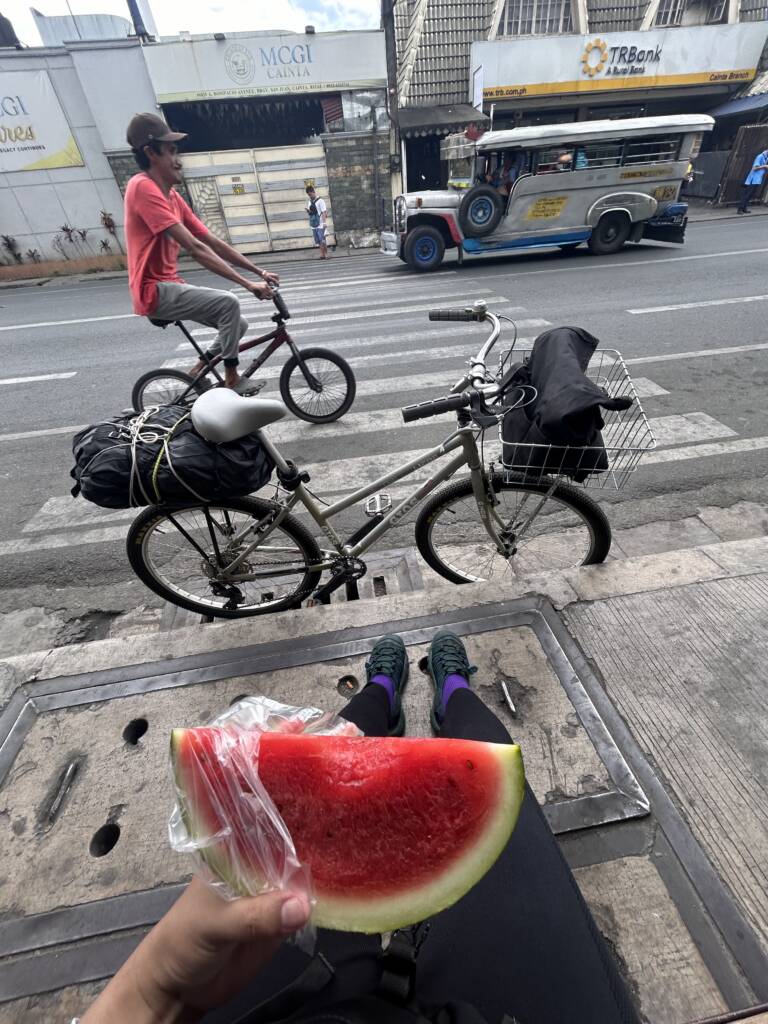Nadia Cruz
I packed and strapped my things onto my bike as I prepared myself for work. Part of my commute involves assigning bike stops where I can take short breaks to eat, hydrate, and sometimes chat with locals. Cyclists share an unspoken solidarity as most bikers look out for each other amidst the hectic streets and scorching heat. Despite roads are being occupied with private cars, roads that cater active mobility, such as cycling, create a culture of steadiness, mindfulness, and sustainability. The act of biking is a liberating experience for me; it offers opportunities for discovery and learning from others. All this happens during my 3-hour journey to work. Recognizing my own pace prevents exhaustion; it also doubles as a form of exercise and practically speaking, it saves me money. However, while I can ensure my hydration, concerns about road safety often loom overhead.

Taking a short break at a sari-sari store in Cainta, Rizal on my way to work. I have already biked around 15kms at this point and have around 10kms left. There are several street vendors in that area which are all using their bikes to sell food. [Photo: Nadia Cruz]
Like many Filipinos who don’t own cars, we rely on mass transportation and active mobility for commuting to work, school, running errands, and travel. The concept of safe roads should not only pertain to their physical condition but should also imply inclusivity and accessibility for all, especially the vulnerable sectors.
In the ongoing debate over the future of bicycle lanes along EDSA, the recent proposal to remove these lanes in favor of an exclusive motorcycle lane has sparked concerns among advocates of sustainable transportation.
This move, spearheaded by Metropolitan Manila Development Authority (MMDA) Chairman Romando Artes, represents a significant step backward in promoting environmentally friendly modes of transport and equitable road space allocation in the Philippines.
EDSA is a crucial thoroughfare, yet its road space allocation fails the 88% of Filipinos in Metro Manila who don’t own cars. We need dedicated bus lanes, improved pedestrian sidewalks, and bike lanes that cater to everyone, not just cars. Without better options, people will be forced to buy cars, worsening EDSA’s traffic.

A Bilang Siklista volunteer counts people-riding-bicycles along EDSA Cubao during the 2023 bike count. [Photo: Francis Manaog]
The decision to consider removing bicycle lanes disregards the needs and safety of cyclists, as well as the substantial investments made in establishing these lanes. The Department of Transportation’s Active Transport and Safe Pathways Program (ATSPP) recently allocated a substantial budget of P1 billion for protected bike lanes and pedestrian walkways, reflecting a commitment to sustainable mobility. However, the proposed removal of bike lanes contradicts this progress and undermines previous investments.
Despite the growing popularity of cycling, the MMDA has banned motorcycles and light electric vehicles (EVs) from EDSA, further limiting the options for sustainable transport. The proposed shift to a shared bike and motorcycle lane raises safety concerns, as it would mix fast-moving motorcycles with slower cyclists, potentially increasing the risk of accidents.
Data from the Social Weather Stations (SWS) survey indicates that cycling is a popular mode of transportation in the Philippines, with one out of three households owning at least one bicycle. Additionally, the latest Bilang Siklista report recorded 7,807 cyclists at key points along EDSA, highlighting the significant number of cyclists who rely on these lanes for safe and efficient travel.
Many organizations are calling out the Metropolitan Manila Development Authority (MMDA) on its claim that EDSA bike lanes are underused. MMDA’s 2020 report recorded 756,755 cyclists on key routes, soaring to 1,662,960 in the first half of 2022. The MMDA didn’t disclose 2023 data, relying instead on a count during Typhoon Egay.
Even by MMDA’s count, 1,786 cyclists vastly exceeds pre-pandemic numbers, proving “Build, and they will come.” The conflicting figures highlight the need for thorough analysis and transparency. Transport planners and academia should scrutinize MMDA’s methodology. Removal of bike lanes must consider the safety and needs of the 1,700+ cyclists currently using them.

A cyclist using the bike lane at San Juan. Bikeable roads ensure the safety of the bikers.[Photo: Nadia Cruz]
As part of the convenors of the Mobility Awards we stand with the community of inclusive mobility and transport advocates in urging the MMDA to reject the proposal to remove bike lanes along EDSA. We call on the MMDA to work closely with the Department of Transportation to develop a public transport system that serves everyone and addresses traffic congestion more comprehensively. Additionally, we urge the MMDA to make their bike counts consistent and expand their count observation points in key EDSA intersections, ensuring that all modes of transport are accurately monitored and accounted for.
The removal of bike lanes along EDSA is a regressive step that undermines efforts to promote sustainable transportation in Metro Manila. We encourage all stakeholders to join us in advocating for a more inclusive and sustainable approach to urban mobility.
Our roads are meant to move people, not cars.

